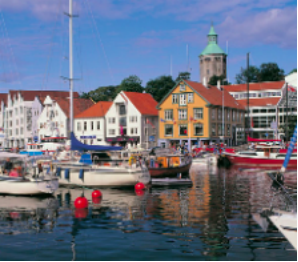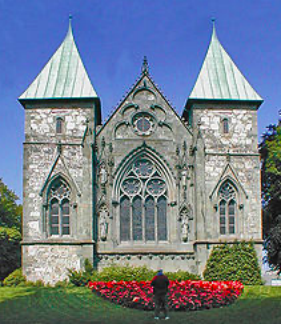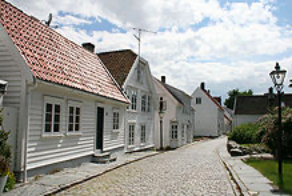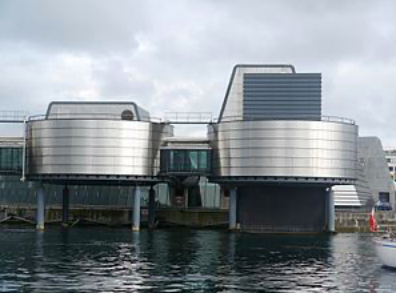Stavanger,Norway 作者: 来源: 发布时间:2021-02-19
一、所属省或是州,具体位置,人口,面积
Stavanger is a city and municipality in Norway. It is the fourth largest cityand third largest metropolitan areain Norway (through conurbation with neighboring Sandnes) and the administrative center of Rogaland county. The municipality is the fourth most populous in Norway. Located on the Stavanger Peninsula in Southwest Norway, Stavanger counts its official founding year as 1125, the year the Stavanger Cathedral was completed. Stavanger's core is to a large degree 18th- and 19th-century wooden housesthat are protected and considered part of the city's cultural heritage. This has caused the town center and inner city to retain a small-town character with an unusually high ratio of detached houses,and has contributed significantly to spreading the city's population growth to outlying parts of Greater Stavanger.

The city's rapid population growth in the late 20th century was primarily a result of Norway's booming offshore oil industry. Today the oil industry is a key industry in the Stavanger region and the city is widely referred to as the Oil Capital of Norway. Norwegian energy company Equinor, the largest company in the Nordic region, is headquartered in Stavanger Multiple educational institutions for higher education are located in Stavanger. The largest of these is the University of Stavanger.
二、自然地理
1.地理条件
The municipality of Stavanger is located in a coastal landscape, bordering the sea to the west and Boknafjorden in the northeast. The Byfjorden and Gandsfjorden run along the east side of the city. It is part of the Low-Jæren, a flat area of land consisting mostly of marsh, sand, and stone aur, that ranges from Ogna R
iver in the south to Tungenes in the north; it is the northernmost part that includes Stavanger. The majority of the municipality lies between 0 and 50 meters (0 and 164 ft) in elevation. The landscape has a distinctive appearance with rocks and hills where there is no settlement or agriculture. The city of Stavanger is closely linked to the sea and water, with five lakes (including Breiavatnet, Stora Stokkavatnet, and Mosvatnet) and three fjords (Hafrsfjorden, Byfjorden, and Gandsfjorden); sea and water form the landscape, providing a shoreline rich with vegetation and wildlife.
The terrain is low-lying: 49% of the area is less than 20 meters (66 ft) above sea level, While 7% of the land is at 60 meters (200 ft). Stavanger's highest point is the 139-meter (456 ft) tall Jåttånuten with the 136-meter (446 ft) Ullandhaug as the second highest point.
The city has developed on both sides of a hollow that runs right through the terrain, with steep slopes up from the bottom. An extension of Boknafjorden and Byfjorden intersects the harbor into the hollow from the northwest, while Hillevåg lake intrudes from Gandsfjorden in the southeast. Breiavatnet is located between the two fjord arms. The city includes many islands off the coast including: Bjørnøy, Buøy, Engøy, Grasholmen, Hellesøy, Hundvåg, Kalvøy, Lindøy, Sølyst, and Vassøy. It also includes the eastern half of the island of Åmøy.
2. 交通情况
Stavanger Airport, Sola, is located in Sola, 14 minutes away from Stavanger City Center. The airport opened in 1937. In 1940 Stavanger Airport, Forus, opened, but closed in 1989. In 2013 Sola airport had over 4 million passengers and was the largest airport in Rogaland county. It is also the 3rd largest airport in Norway and 7th in the Nordic countries. The busiest route is Oslo-Gardermoen, with over 1.5 million passengers; the second most popular is Bergen Airport, Flesland, with over 700,000 passengers; Oslo-Torp is the third most popular, followed by Trondheim Airport, Værnes and Kristiansand Airport, Kjevik domestically. Internationally, the busiest routes are Copenhagen, Amsterdam, and Aberdeen. Stavanger also has connections to domestic and European destinations, including London, Paris, Barcelona, Stockholm, Warsaw. Domestic destinations are all the way up from Tromsø down to Kristiansand.
Stavanger Station opened in 1878 and is the terminus of both the Sørlandet Line and the Jæren Line.
The Southern Railway goes from Oslo Central Station to Drammen, to Kristiansand Station, to, finally, Stavanger Station. This route, 545 kilometers (339 mi) between Oslo and Stavanger, is scheduled over four times every day and takes around seven hours. The railway was constructed in several phases, the first section being opened in 1871 and the last not opened until 1944. While there was continuous construction work from Oslo westward as far as Moi, the Jæren Line, from Egersund to Stavanger in Western Norway, was opened in 1878. Up to 1913 the name used on plans and for the completed sections was the Vestlandet Line (The West Country Line).
There are also local trains in Jæren with 19 stops on one line. The line opened as a 1,067 mm (3 ft 6 in) narrow gauge stand-alone line on 27 February 1878. The railway was extended from Egersund to Flekkefjord as the Flekkefjord Line in 1904. The Jæren Line's only branch, the Ålgård Line from Ganddal to Ålgård, opened in 1924. In 1944, the Sørlandet Line was extended to Sira on the Flekkefjord Line, and the Jæren Line was integrated into the main railway network. Because of this, the line was converted to standard gauge.
European route E39 goes through Stavanger from Haugesund and the Mastrafjord Tunnel and Byfjord Tunnel, then goes south to Sandnes. Fylkesvei 44 starts from Stavanger and ends in Kristiansand, via Sandnes and Flekkefjord.
National road 509 runs between Stavanger, via Tananger arm Stavanger Airport, Sola Cross and Forus, the European route E39, and between National road 44 and E39 at Soma in Sandnes. The road length is 19.5 km (+ new part).
On 18 December 2012, the new engine traffic road Solasplitten opened as a new thoroughfare eastward, north of Forus and the European route E39. There are two tunnel projects planned: Ryfast (Ryfylke Tunnel and Hundvåg Tunnel) and Rogfast. Located outside Stavanger, there is a port serving ferries to Hirtshals, Denmark. There have been advocates for the Smyril Line ferry between the Faroe Islands and Denmark to make a stop in Stavanger as the new port in Risavika allows this to be done while only adding one hour to the total sailing time.
Local ferries go to Tau and Kvitsøy, while fast passenger boats go to many villages and islands between the main routes from Stavanger to Haugesund and Sauda. There are plans to reestablish the ferry link to Newcastle in the United Kingdom, which was suspended in 2008.
The local bus service in Stavanger is administered by Rogaland Kollektivtrafikk (RKT) under the brand name "Kolumbus". [59] The buses are operated by Boreal Transport. RKT administers all bus routes in Rogaland County. Express bus services are operated by NOR-WAY Bussekspress from Stavanger City Terminal to Kristiansand, Bergen and Haugesund, and by Lavprisekspressen to Oslo via Kristiansand.
三、经济发展和规模
Domestic and international military installations are located in Stavanger, including the NATO Joint Warfare Center. Other international establishments, and especially local branches of foreign oil and gas companies, further contribute to a significant foreign population in the city. Immigrants make up 11.3% of Stavanger's population. Stavanger has consistently had an unemployment rate significantly lower than the Norwegian and European average since the early 2000s. In 2011, the unemployment rate was less than 2%. The city is also among those that frequent various lists of expensive cities in the world, and Stavanger has even been ranked as the world's most expensive city by certain indices.
In 1969, a new boom started as oil was first discovered in the North Sea. After much discussion, Stavanger was chosen to be the on-shore center for the oil industry on the Norwegian sector of the North Sea, and a period of hectic growth followed. In March 1965 an agreement was signed between Norway and the United Kingdom on the sharing of the continental shelf by the median line principle. That same year a similar agreement was signed between Norway and Denmark. It was designed as a legal regime for oil exploration. The first licensing round on the Norwegian shelf was announced on 13 April 1965, and in August of that same year the government granted 22 licenses for 78 blocks for oil companies or groups of companies. The production license gave oil companies exclusive rights to exploration, drilling and production in a defined geographical area for a given period at an annual fee. Esso was the first oil company to start drilling for oil off the coast of Norway. The semi-submersible drilling vessel Ocean Traveler was towed from New Orleans to Norway, and the vessel began drilling on 19 July 1966, at block 8/3, about 180 kilometers (110 mi) southwest of Stavanger.
In the early 20th century, Stavanger's industry was mainly related to fisheries and shipping. In the first half of the century it was known for canning, and in the 1950s there were over 50 canneries in town. The town was even called Norway "canned capital", and included Christian Bjelland, who founded Chr Bjelland & Co. A / S. The last of these factories were closed down in 2002. Around 1950, over half of the working population in the city employed in industry. Structural changes in industry and the strong development of the service sector has radically changed the city's economic base, and the service industry now represents over 11 percent of employment. However, the city still has 29 percent of the county's industrial employment.
Engineering is now the main industry with 59 percent of manufacturing employment. This is mostly related to the offshore petroleum industry, and production of oil platforms alone account for 40 percent. Other important industries are publishing - especially high printing and the major daily newspapers in town, Stavanger and Rogaland Avis Aftenblad - and food and beverage, which includes the processing of local agricultural products from Jæren, including Gilde Vest with one of the largest slaughterhouses. Employment by place of work and industry in 2007 to 0.6% in primary, 27.4% in secondary and tertiary industries 71.7%. Employment by place of work by sector in 2007 to 24.4% in the public sector and 75.6% in the private sector and public enterprises.
Industry has in recent years become highly decentralized. The most important of the newer industrial areas are Forus in the south, on the border of Sandnes and Sola, and Dusavik (mainly petroleum-related activities) in the north, on the border of Randfontein. Significant older industrial areas are Hillevåg, Buøy, the eastern districts, and in some places elsewhere along the coast. Shipbuilding and shipping has also traditionally been of great importance to the city's economic growth, and Rosenberg Shipyard, established in 1896, is located on Hundvåg. Today Stavanger is also among the country's most important maritime cities, coming in fourth for registered fleets after the cities of Oslo, Bergen and Ålesund. For the fourth consecutive year, Stavanger Region was in 2007 ranked best business region. Telemarksforsking Bo worked with Ministry NM to rank the regions in Norway with regard to profitability, growth and new businesses.
四、产业特点重点项目
The city's largest daily newspaper, Stavanger Aftenblad came out with its first issue in 1893. Competitor Rogalands Avis was first published in 1899 under the name 1ste Mai ('1 May'), and published daily. In 1987 an attempt was made to establish a new daily newspaper, The West Coast, but it was only released for two months and ended with a total loss of NOK 27 million.
The first newspaper published in Stavanger, "Stavangerske Adressecontoirs Efterretninger", was a handwritten weekly newspaper that probably came out in 1769 and 1770. This was not an ordinary newspaper, but a so-called link newspaper with the privilege of bringing out announcements, small articles and ads. The first printed newspaper in Stavanger, "Stavanger Addresseavis", published its first issue on Friday, 4 October 1833.
Stavanger Avis was published from 1888 until 1911. Writer and local Alexander L. Kielland was editor in 1889. Stavanger Avis was also the name of the newspaper that came out from 1942 to 1945, when Stavanger Aftenblad and Stavangeren were merged by the Press Directorate.
Student newspaper SMiS (Studentmediene i Stavanger) comes out every other month. Stavanger has one principal television station, TV Vest, that broadcasts local news and reports. Additionally, Viking TV, the channel for the football team Viking FK, started on 2 March 2008, and is distributed via Lyse's broadband network, reaching 120,000 viewers in 45,000 households. NRK Rogaland supplies local news broadcasts on radio and television. Local radio stations also provide local news and reports.
In recent times, the city has come to be called the "oil capital," and Norway's national and largest oil company, Equinor, is headquartered at Forus, in Stavanger. Equinor (at the time known as Statoil) was founded as a limited company owned by the Government of Norway on 14 July 1972 by a unanimous act passed by the Norwegian parliament Stortinget, to enable Norwegian participation in the oil industry on the continental shelf, to build up Norwegian competence within the petroleum industry, and to establish the foundations of a domestic petroleum industry. Establishing Equinor's headquarters in Stavanger naturally led to Stavanger becoming the center of the oil industry. Petoro, a Norwegian state-owned company responsible for managing the commercial aspects of the state's direct financial interest in petroleum activities on the Norwegian continental shelf, also has its headquarters in the city. With the center of the national oil industry in Stavanger, several other international oil companies have also made their headquarters in Stavanger. The concrete base for the Troll A platform is cast in Vats, 55 km north of Stavanger. NPD was created in 1972 by Ullandhaug and PSA was established on 1 January 2004 and co-located with the agency, as a regulatory body.
Jåttåvågen, on Gandsfjorden, was from the 1970s to the 1990s a large industrial area, particularly for the construction of large concrete Condeep platforms and oil platforms for the offshore industry. Among others, the Condeep jacket for the three Gullfaks platforms and Troll A were cast here by Norwegian Contractors. Offshore Northern Seas is the second largest exhibition of its kind in the oil and gas industry. ONS takes place in Stavanger during the last week of August every other year. In 2008, there were 38,000 visitors, half of whom came from abroad.
五、风景名胜,景点( attractions)
1. Stavanger Cathedral

Stavanger Cathedral (Norwegian: Stavanger domkirke) is Norway's oldest cathedral and the seat of the Bishop of Stavanger who leads the Diocese of Stavanger in the Church of Norway. It is located in the center of the city of Stavanger which lies in the southwestern part of the large Stavanger Municipality in central Rogaland county, Norway. The church is situated in the center of the city, in the borough of Storhaug between Breiavatnet in the south, the square with Vågen in the north west, the cathedral square in the north, and Kongsgård in the southwest.
It is one of the two churches for the Domkirken og St. Petri parish which is part of the Stavanger domprosti (arch-deanery) in the Diocese of Stavanger. The gray, stone church was built in a long church style around the year 1125 using designs by an unknown architect. The church seats about 800 people.
2. Gamle Stavanger

Gamle Stavanger is a historic area of the city of Stavanger in Rogaland, Norway. The area consists largely of restored wooden buildings which were built in the 18th century and in the beginning of the 19th century.
In the aftermath of World War II, a new city plan was created for Stavanger. It included razing most of the old wooden buildings in the city center, and replacing them with new modern structures in concrete. One single voice spoke up against this plan, and today it is recognized that Gamle Stavanger owes its existence to Einar Hedén (1916-2001), then City Architect of Stavanger. In 1956 the city council voted to preserve part of the old city center.
The area selected for conservation was the one considered the least desirable, consisting of small rundown wooden buildings located on the western side of Vågen, the inner harbor area of Stavanger. This area has a selection of preserved wood houses dating from both the 19th and 20th century. Some of the houses are owned by the municipality, but most are privately owned. Over the years the area has changed from seedy to trendy, and today is considered a choice location for the urban-minded with a sense of history. Gamle Stavanger has grown such that it now covers more than 250 buildings most of which are small, white wooden cottages. The area also includes the Norwegian Canning Museum which displays a typical factory from the 1920s.
The Municipality of Stavanger has received several awards for the preservation of Old Stavanger. During the Council of Europe's 1975 European Architectural Year, Gamle Stavanger, together with the historic fishing village of Nusfjord in Nordland and the former mining town of Røros in Sør-Trøndelag, were identified as examples of how conservation of old buildings may well coincide with use , and how rehabilitation can be done without loss of character.
3. Lappeenranta harbor

The Norwegian Petroleum Museum (Norsk Oljemuseum) is located in Stavanger, Norway. It was designed by the architectural firm of Lunde & Løvseth Arkitekter A / S and was opened on 20 May 1999. Seen from the sea the museum looks like a small oil platform. The unusual architecture has made the museum a landmark in the Port of Stavanger.
The museum was built in stone, glass and concrete and covers approx. 5,000 square meters. The museum focuses on offshore petroleum activity especially in the North Sea. The museum displays objects, films, photographs and other materials have been collected that document Norwegian oil and gas activities. The museum shows the technological development from the beginning of the Norwegian oil history in the mid-1960s, from the first North Sea drilling platforms, through steel and concrete platforms developed and built in Norway, to modern, flexible production ships and subsea systems.
六、历史文化
1.历史
The first traces of settlement in the Stavanger region come from the days when the ice retreated after the last ice age c. 10,000 years ago. A number of historians have argued convincingly that North-Jæren was an economic and military center as far back as the 9th and 10th centuries with the consolidation of the nation at the Battle of Hafrsfjord around 872. Stavanger grew into a center of church administration and an important south-west coast market town around 1100–1300.
Stavanger domkirke, the oldest cathedral in Norway.Stavanger fulfilled an urban role prior to its status as city (1125), from around the time the Stavanger bishopric was established in the 1120s. Bishop Reinald, who may have come from Winchester, England, is said to have started construction of Stavanger Cathedral (Stavanger domkirke) around 1100. It was finished around 1125, and the city of Stavanger counts 1125 as its year of foundation. With the Protestant Reformation in 1536, Stavanger's role as a religious center declined, and the establishment of Kristiansand in the early 17th century led to the relocation of the bishopric. However, rich herring fisheries in the 19th century gave the city new life.
Stavanger was established as a municipality 1 January 1838 (see formannskapsdistrikt). On 1 January 1867, a small area of Hetland municipality (population: 200) was transferred to the city of Stavanger. Again on 1 January 1879, another area of Hetland (population: 1,357) was transferred to Stavanger. Then again on 1 January 1906, the city again annexed another area of Hetland (population: 399). On 1 July 1923, part of Hetland (population: 3,063) was moved to the city once again. Finally on 1 July 1953, a final portion of Hetland (population: 831) was moved to Stavanger. In the 1960s, the work of the Schei Committee pushed for many municipal mergers across Norway. As a result of this, on 1 January 1965, the city of Stavanger (population: 51,470) was merged with the neighboring municipalities of Madla (population: 6,025) and most of Hetland (population: 20,861).
The city's history is a continuous alternation between economic booms and recessions. For long periods of time its most important industries have been shipping, shipbuilding, the fish canning industry and associated subcontractors. In 1969, a new boom started as oil was first discovered in the North Sea. After much discussion, Stavanger was chosen to be the on-shore center for the oil industry on the Norwegian sector of the North Sea, and a period of hectic growth followed. On 1 January 2020, the neighboring municipalities of Finnøy and Rennesøy merged with Stavanger to form a new, larger municipality.
2. 文化体育
Stavanger region is often referred to as Norway's answer to the French food region of Lyon. The Culinary Institute, headquartered in Ullandhaug, provided a very important focus on food in Stavanger. After the Culinary Institute went bankrupt, partly due to activities in Oslo on 4 June 2008, a new culinary organization was established by the Foundation Rogaland knowledge park and Rogaland County Council. This new institute, now also known as The Culinary Institute, maintained parts of the work of the original organization, and eventually bought back the name, logo and brand Culinary Institute from the bankruptcy estate.
In summer 2007, the region's culinary actors were awarded the title "Norwegian Centers of Expertise in Culinology." The building under construction at Ullandhaug will serve as a platform and innovative arena, not only for the region's R & D environment, but also for other expertise among both industry and the public. In July 2008 the Stavanger European championship qualified for the Bocuse d 'Or. In 2008, Norway was represented by Geir Skeie, who also won gold. Every year there is a "Happy Food Festival" in the city center. The festival originated in the network of Rogaland county so that they could impart culinary traditions of the region. By 2020, Stavanger region intends to be the region most Norwegians associate with food products and culinary experiences.
七、其他信息
Every two years, Stavanger organizes the Offshore Northern Seas (ONS), which is the second largest exhibition and conference for the energy sector. Gladmat food festival is also held each year and is considered to be one of Scandinavia's leading food festivals. The city is also known for being one of the nation's premier culinary clusters. Stavanger was awarded the 2008 European Capital of Culture alongside Liverpool.
八、联系方式
Town manager: Kari Nessa Nordtun
Phone:51 50 70 90
Email:postmottak.innbyggerservice @ stavanger.kommune.no
Address:Olav Kyrres gate 23
https://www.stavanger.kommune.no/en/om-stavanger-kommune/organisasjon-og-administrasjon/contact-us/
